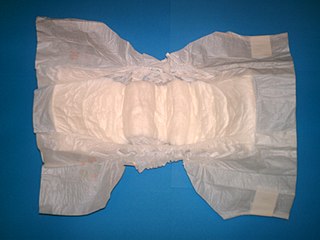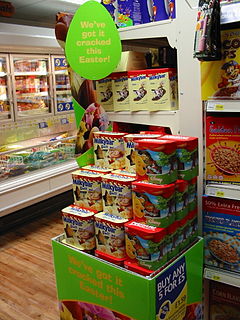
A diaper or a nappy is a type of underwear that allows the wearer to defecate or urinate without the use of a toilet, by absorbing or containing waste products to prevent soiling of outer clothing or the external environment. When diapers become soiled, they require changing, generally by a second person such as a parent or caregiver. Failure to change a diaper on a sufficiently regular basis can result in skin problems around the area covered by the diaper.

Kleenex is a brand name for a variety of paper-based products such as facial tissue, bathroom tissue, paper towels, tampons, and diapers. Often used informally as a genericized trademark for facial tissue in the United States, the name Kleenex is a registered trademark of Kimberly-Clark Worldwide, Inc. Kleenex products are manufactured in 30 countries and sold in more than 170 countries. Kleenex brands include Cottonelle, Huggies, and VIVA.
Kimberly-Clark Corporation is an American multinational personal care corporation that produces mostly paper-based consumer products. Kimberly-Clark brand name products include Kleenex facial tissue, Kotex feminine hygiene products, Cottonelle, Scott and Andrex toilet paper, Wypall utility wipes, KimWipes scientific cleaning wipes, and Huggies disposable diapers and baby wipes.
The design life of a component or product is the period of time during which the item is expected by its designers to work within its specified parameters; in other words, the life expectancy of the item. It is the length of time between placement into service of a single item and that item's onset of wearout.

Cutlery includes any hand implement used in preparing, serving, and especially eating food in Western culture. A person who makes or sells cutlery is called a cutler. The city of Sheffield in England has been famous for the production of cutlery since the 17th century and a train – the Master Cutler – running from Sheffield to London was named after the industry. Bringing affordable cutlery to the masses, stainless steel was developed in Sheffield in the early 20th century.

A sanitary napkin, sanitary towel, sanitary pad, menstrual pad, or pad is an absorbent item worn in the underwear by women and girls who are menstruating, bleeding after giving birth, recovering from gynecologic surgery, experiencing a miscarriage or abortion, or in any other situation where it is necessary to absorb a flow of blood from the vagina.

A water bottle is a container that is used to hold water, liquids or other beverages for consumption. The use of a water bottle allows an individual to drink and transport a beverage from one place to another.
The throw-away society is a human society strongly influenced by consumerism. The term describes a critical view of overconsumption and excessive production of short-lived or disposable items over durable goods that can be repaired.

A disposable is a product designed for a single use after which it is recycled or is disposed as solid waste. The term often implies cheapness and short-term convenience rather than medium to long-term durability. The term is also sometimes used for products that may last several months to distinguish from similar products that last indefinitely. The word "disposables" is not to be confused with the word "consumables" which is widely used in the mechanical world. In welding for example, welding rods, tips, nozzles, gas, etc. are considered to be "consumables" as they last only a certain amount of time before needing to be replaced.

Sodium polyacrylate, also known as waterlock, is a sodium salt of polyacrylic acid with the chemical formula [−CH2−CH(CO2Na)−]n and broad application in consumer products. This superabsorbent polymer has the ability to absorb 100 to 1000 times its mass in water. Sodium polyacrylate is an anionic polyelectrolyte with negatively charged carboxylic groups in the main chain. While sodium neutralized polyacrylic acids are the most common form used in industry, there are also other salts available including potassium, lithium and ammonium.
Non-woven fabric is a fabric-like material made from staple fibre (short) and long fibres, bonded together by chemical, mechanical, heat or solvent treatment. The term is used in the textile manufacturing industry to denote fabrics, such as felt, which are neither woven nor knitted. Some non-woven materials lack sufficient strength unless densified or reinforced by a backing. In recent years, non-woven have become an alternative to polyurethane foam.

A point-of-sale display is a specialized form of sales promotion that is found near, on, or next to a checkout counter. They are intended to draw the customers' attention to products, which may be new products, or on special offer, and are also used to promote special events, e.g. seasonal or holiday-time sales. POS displays can include free standing display units (FSDU), shelf edging, dummy packs, strut cards, standees, hanging signs, counter display units (CDU), display packs, endcaps, display stands, mobiles, posters, and banners. POS can also refer to systems used to record transactions between the customer and the commerce.
Personal care or toiletries are consumer products used in personal hygiene and for beautification.
The razor and blades business model is a business model where in one item is sold at a low price in order to increase sales of a complementary good, such as consumable supplies. For example, inkjet printers require ink cartridges, and game consoles require accessories and software. It is distinct from loss leader marketing and free sample marketing, which do not depend on complementary products or services.
Packaging most often refers to packaging and labeling, including

Disposable food packaging comprises disposable items often found in fast food restaurants, takeout restaurants and kiosks, and catering establishments. Food serving items for picnics and parties are very similar. Typical disposable foodservice products are foam food containers, plates, bowls, cups, utensils, doilies and tray papers. These products can be made from a number of materials including plastics, paper, bioresins, wood and bamboo.
Single Use Systems (SUS) and Single use components are increasingly popular methods of pharmaceutical and biologics production. They differ from traditional Biopharmaceutical process systems in that they are disposed of after use as opposed to cleaned or CIP'd.

Wi, Inc. is an American medical device development corporation incorporated and headquartered in Englewood, CO. Wi specializes in in-vitro diagnostic microfluidic disposable cartridges and instruments, biological assays on and off disposable cartridges, and electromechanical devices. In 2004, Wi was a Gold Winner of the Medical Design Excellence Awards for the LifePort Kidney Transporter.

A bag is a common tool in the form of a non-rigid container. The use of bags predates recorded history, with the earliest bags being no more than lengths of animal skin, cotton, or woven plant fibers, folded up at the edges and secured in that shape with strings of the same material.

A disposable cup is a type of tableware and disposable food packaging. Disposable cup types include paper cups, plastic cups and foam cups. Expanded polystyrene is used to manufacture foam cups, and polypropylene is used to manufacture plastic cups.











